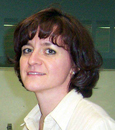| |
Nathalie Arbour, Ph.D.
 Nathalie Arbour is a assistant researcher in the Department of Medicine of the Université de Montréal. Her laboratory is located at the CHUM Research Centre and specializes in neuro-immunology. Nathalie Arbour is a assistant researcher in the Department of Medicine of the Université de Montréal. Her laboratory is located at the CHUM Research Centre and specializes in neuro-immunology.
CONTACT
CHUM-Hopital Notre-Dame
JA De Seve Building
Room Y-3609
1560 Sherbrooke Street East
Montreal, Quebec
Canada H2L 4M1
Phone: 514-890-8000 ext. 25112 (office) or 25625 (lab)
Fax: 514-412-7602
E-mail:
:nathalie.arbour@umontreal.ca
SUMMARY OF RESEARCH ACTIVITIES
The main focus of my research is to elucidate the mechanisms implicated in the detrimental dialogue between two very complex systems: the central nervous system (CNS) and the immune system. Since the brain is an organ that is excessively sensitive to metabolic changes and often incompletely recovers from attacks, the CNS has developed inherent mechanisms to restrain immune responses. The immunoprivileged character of the CNS expressed by limited migration of immune cells and minimal basal expression of the major histocompatibility complex molecules, creates a unique environment that influences the immune system’s capacity to function. Despite the beneficial contribution of the immune response in eliminating pathogens from the CNS, these same responses can damage neurons or glial cells and in this way participate in the pathogenesis of diseases including demyelinating, neurodegenerative and viral-induced diseases. My research activities concentrate on the contribution of CD8 T cells to the pathogenesis of multiple sclerosis (MS) and are likely to provide crucial information regarding other CNS diseases in humans.
- Main objectives:
1. Elucidate the factors and mechanisms that contribute to the detrimental dialogue between the central nervous system and the immune system.
- Evaluate the contribution of NK (NKG2D, NKG2C, NCR) cell receptors expressed by CD8 T cells, to harmful attacks on the central nervous system.
- Determine the contribution of the central nervous system to maintenance and local activation of T cells through production of cytokines (IL-15, IL-27, TGF-) and other mediators.
- Characterize T cells that contribute to inflammatory attacks against the central nervous system (phenotype, cytotoxic activity, immunosuppression).
STUDIED DISEASES
Multiple sclerosis (MS). In Canada, MS affects between 55,000 and 75,000 patients. The causes of this disease remain unknown and there is no cure available. Genetic and environmental factors are implicated in the susceptibility to this disease and its development. The pathology of MS is characterized by immune cells infiltration into the CNS, the destruction of oligodendrocytes (cells that produce and maintain the myelin sheath), and by axonal loss
PRINCIPALES PUBLICATIONS
Cayrol R., K. Wosik, J.L. Berard., A. Dodelet-Devillers, I. Ifergan, H. Kebir, A.S. Haqqani, K. Kreymborg, S. Krug, R. Moumdjian, A. Bouthillier, B. Becher, N. Arbour, S. David, D. Stanimirovic, and A. Prat. 2008. ALCAM promotes leukocyte trafficking into the central nervous system. Nature Immunology doi:10.1038/ni1551
Ifergan I, H. Kébir, M. Bernard, K. Wosik, A. Dodelet-Devillers, R. Cayrol, N. Arbour, and A. Prat. 2007. Th1- and Th17-inducing CNS dendritic cells arise from blood monocytes under the influence of blood-brain barrier-secreted TGF-β and GM-CSF. Brain doi:10.1093/brain/awm295
Kébir, H. K. Kreymborg, I. Ifergan, A. Dodelet-Devillers, R. Cayrol, M. Bernard, F. Giuliani, N. Arbour, B. Becher, and A. Prat. 2007. Human TH17 lymphocytes promote blood-brain barrier disruption and CNS inflammation. Nature Medicine 13(10):1173-5. Jack C. S., N. Arbour, M. Blain, U.C. Meier, A. Prat, and J. P. Antel. 2007 Th1 Polarization of CD4+ T cells by TLR3-activated Human Microglia. Journal of Neuropathology and Experimental Neurology 66:848-5.
Saikali P., J.P. Antel, J. Newcombe, Z. Chen, M. Freedman, M. Blain, R. Cayrol, A. Prat, J.A. Hall and N. Arbour*. 2007. NKG2D mediated cytotoxicity towards oligodendrocytes suggests a mechanism for tissue injury in multiple sclerosis. Journal of Neuroscience 27(5):1220-8.
Arbour N.*, R. Lapointe, P. Saikali, E. McCrea, T. Regen, and J.P. Antel. A new clinically relevant approach to expand myelin specific T cells. 2006. Journal of Immunological Methods 310:53-61.
Jack, C, N. Arbour, J. Manusow, V. Montgrain, M. Blain, E. McCrea, A. Shapiro, and JP Antel. 2005. TLR signaling tailors innate immune response in human microglia and astrocytes. Journal of Immunology 175:4320-30.
Ruffini F., N. Arbour, M. Blain, A. Olivier, and J.P. Antel. 2004. Distinctive properties of human adult brain derived myelin progenitor cells. American Journal of Pathology 165: 2167-75.
Arbour N*., A. Holz, J.C. Sipe, D. Naniche, J.S. Romine, J. Zyroff, and M.B.A. Oldstone. 2003. A new approach for evaluating antigen specific T cell responses to myelin antigens during the course of multiple sclerosis. Journal of Neuroimmunology 137:197-209
Arbour N., D. Naniche, D. Homann, R.J. Davis, R.A. Flavell, and M. B. A. Oldstone. 2002. c-Jun NH(2)-terminal kinase (JNK)1 and JNK2 signaling pathways have divergent roles in CD8+ T cell mediated antiviral immunity. Journal of Experimental Medicine 195: 801-810.
 Top Top
|


 Nathalie Arbour is a assistant researcher in the Department of Medicine of the Université de Montréal. Her laboratory is located at the CHUM Research Centre and specializes in neuro-immunology.
Nathalie Arbour is a assistant researcher in the Department of Medicine of the Université de Montréal. Her laboratory is located at the CHUM Research Centre and specializes in neuro-immunology.